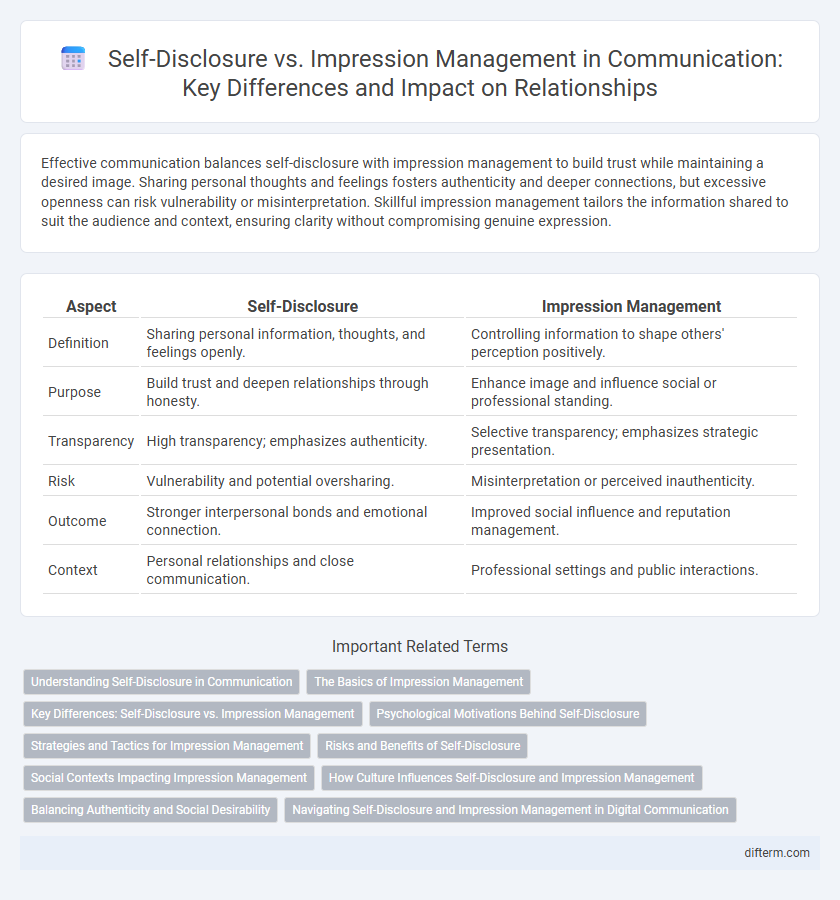Effective communication balances self-disclosure with impression management to build trust while maintaining a desired image. Sharing personal thoughts and feelings fosters authenticity and deeper connections, but excessive openness can risk vulnerability or misinterpretation. Skillful impression management tailors the information shared to suit the audience and context, ensuring clarity without compromising genuine expression.
Table of Comparison
| Aspect | Self-Disclosure | Impression Management |
|---|---|---|
| Definition | Sharing personal information, thoughts, and feelings openly. | Controlling information to shape others' perception positively. |
| Purpose | Build trust and deepen relationships through honesty. | Enhance image and influence social or professional standing. |
| Transparency | High transparency; emphasizes authenticity. | Selective transparency; emphasizes strategic presentation. |
| Risk | Vulnerability and potential oversharing. | Misinterpretation or perceived inauthenticity. |
| Outcome | Stronger interpersonal bonds and emotional connection. | Improved social influence and reputation management. |
| Context | Personal relationships and close communication. | Professional settings and public interactions. |
Understanding Self-Disclosure in Communication
Self-disclosure in communication involves sharing personal information, thoughts, and feelings to build trust and intimacy, which enhances relational closeness. This process contrasts with impression management, where individuals intentionally control or manipulate the information shared to influence others' perceptions. Understanding the balance between authentic self-disclosure and strategic impression management is crucial for effective and meaningful interpersonal communication.
The Basics of Impression Management
Impression management involves strategically controlling the information one shares to influence others' perceptions, emphasizing selective self-disclosure and behavior regulation. Key techniques include expressing socially desirable traits, managing nonverbal cues, and adapting messages to align with audience expectations. This process plays a critical role in shaping interpersonal interactions and maintaining favorable social identities.
Key Differences: Self-Disclosure vs. Impression Management
Self-disclosure involves sharing personal thoughts, feelings, and experiences to build trust and deepen relationships, while impression management focuses on controlling how others perceive you by selectively presenting information. Self-disclosure aims for authenticity and emotional connection, whereas impression management prioritizes strategic image construction and social desirability. Understanding these key differences is essential for effective communication and relationship development.
Psychological Motivations Behind Self-Disclosure
Self-disclosure is driven by psychological motivations such as the need for intimacy, emotional relief, and self-validation, which foster trust and deepen connections in communication. Impression management, however, revolves around controlling others' perceptions to gain social approval or avoid negative judgments. Understanding these motivations highlights the balance individuals maintain between authenticity and social acceptance in interpersonal interactions.
Strategies and Tactics for Impression Management
Effective impression management employs strategies such as self-presentation, ingratiation, and exemplification to shape others' perceptions by highlighting desirable traits and minimizing flaws. Tactics include controlling nonverbal cues, selectively sharing personal information, and adapting communication style to the audience's expectations. Balancing authenticity with strategic self-disclosure enhances credibility while maintaining social desirability in interpersonal interactions.
Risks and Benefits of Self-Disclosure
Self-disclosure fosters trust and deeper connections by revealing personal thoughts and feelings, reducing misunderstandings and promoting authenticity in communication. However, excessive or inappropriate self-disclosure carries risks, such as vulnerability to judgment, loss of privacy, and potential damage to one's reputation. Balancing self-disclosure with impression management allows individuals to build meaningful relationships while protecting their personal boundaries and social image.
Social Contexts Impacting Impression Management
Social contexts significantly influence impression management by shaping the degree and manner of self-disclosure individuals employ to control others' perceptions. In professional environments, individuals often limit personal information to maintain credibility and authority, whereas in close social circles, openness fosters trust and intimacy. Cultural norms and situational expectations further dictate the balance between revealing authentic self-aspects and strategically presenting an idealized image.
How Culture Influences Self-Disclosure and Impression Management
Cultural norms significantly shape self-disclosure and impression management by determining acceptable topics and levels of personal sharing. Collectivist cultures prioritize group harmony, often limiting self-disclosure to maintain social cohesion, while individualistic cultures encourage openness to express individuality. These cultural variations influence communication strategies, affecting trust-building and relationship development across diverse social contexts.
Balancing Authenticity and Social Desirability
Balancing authenticity and social desirability in communication requires carefully navigating self-disclosure and impression management to maintain trust while adapting to social contexts. Effective communicators reveal genuine thoughts and feelings without compromising their image, fostering deeper connections and positive perceptions. Striking this balance enhances relational satisfaction and supports long-term social success.
Navigating Self-Disclosure and Impression Management in Digital Communication
Navigating self-disclosure and impression management in digital communication involves balancing authentic sharing with curated online personas to maintain trust and social connections. Effective digital communicators strategically disclose personal information while managing how others perceive them through selective sharing and privacy settings. Understanding platform-specific norms and algorithms enhances control over self-presentation and mitigates risks of oversharing or misinterpretation.
self-disclosure vs impression management Infographic

 difterm.com
difterm.com